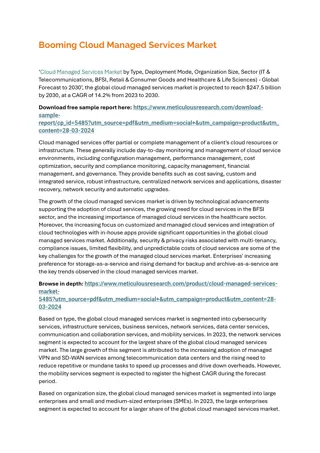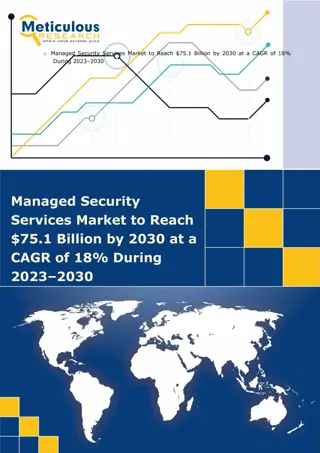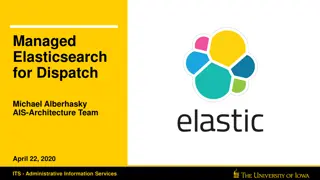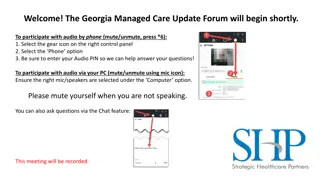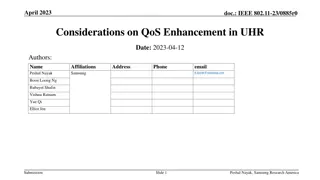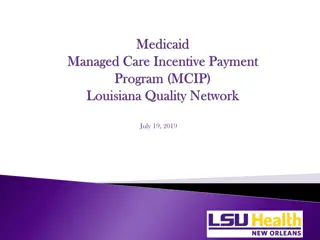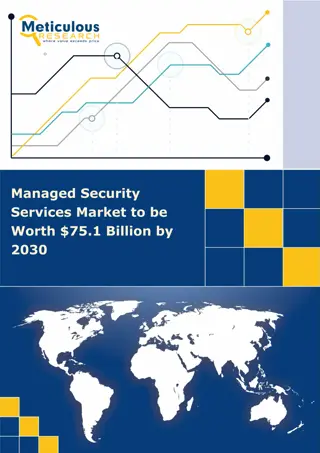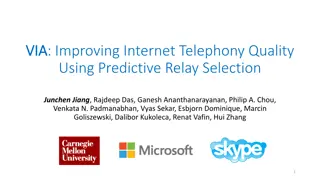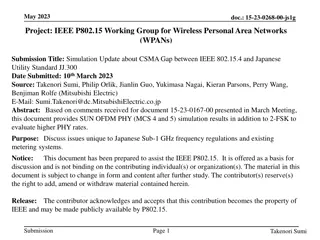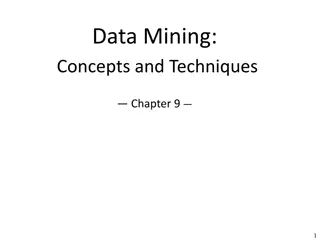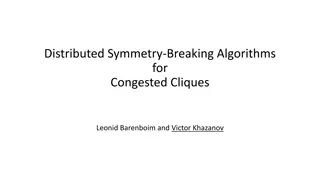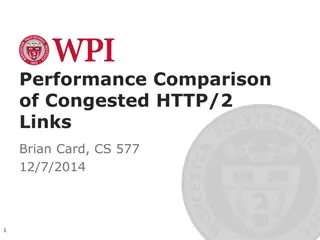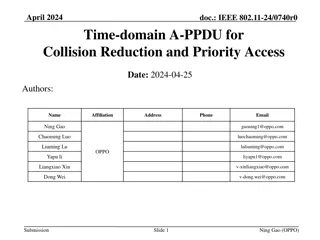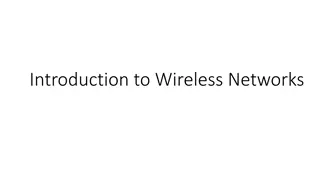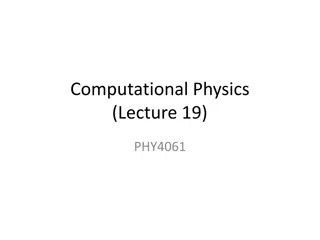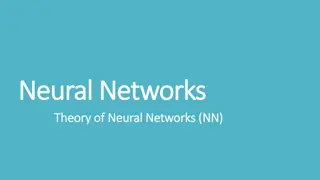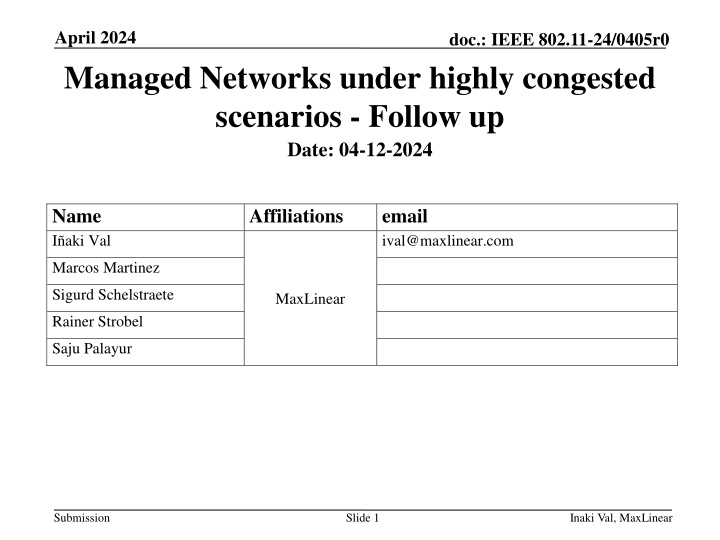
Optimizing Managed Networks for High Congestion Scenarios
Explore technical approaches for enhancing AP-centric architecture in managed networks under highly congested scenarios. Discuss strategies for improving QoS, reducing latency, and ensuring reliable packet delivery.
Download Presentation

Please find below an Image/Link to download the presentation.
The content on the website is provided AS IS for your information and personal use only. It may not be sold, licensed, or shared on other websites without obtaining consent from the author. If you encounter any issues during the download, it is possible that the publisher has removed the file from their server.
You are allowed to download the files provided on this website for personal or commercial use, subject to the condition that they are used lawfully. All files are the property of their respective owners.
The content on the website is provided AS IS for your information and personal use only. It may not be sold, licensed, or shared on other websites without obtaining consent from the author.
E N D
Presentation Transcript
April 2024 Managed Networks under highly congested scenarios - Follow up Date: 04-12-2024 doc.: IEEE 802.11-24/0405r0 Name I aki Val Affiliations email ival@maxlinear.com Marcos Martinez Sigurd Schelstraete MaxLinear Rainer Strobel Saju Palayur Submission Slide 1 Inaki Val, MaxLinear
April 2024 doc.: IEEE 802.11-24/0405r0 Goals Follow up on the previously presented contribution about managed networks under highly congested scenarios Discuss technical approaches for implementing mechanisms that enable an AP centric architecture under OBSS/ESS scenarios Submission Slide 2 Inaki Val, MaxLinear
April 2024 doc.: IEEE 802.11-24/0405r0 Introduction 802.11bn targets the improvement of packet delivery by reducing the transmission latency and enhancing network reliability [1] Applications and use cases with QoS-related requirements (e.g., bounded latency and reliability) have been growing in recent times [2] The critical QoS services can be mainly characterized by periodic traffic patterns, and strict timing requirements for data exchange [2, 3] Relying on maximizing throughput is not tenable in the long term as a sole requirement for correct QoS service operation, especially under heavily congested scenarios Several contributions presented different approaches based on the AP centric architecture or managed networks [4, 5] Submission Slide 3 Inaki Val, MaxLinear
April 2024 doc.: IEEE 802.11-24/0405r0 General Assumptions We distinguish two types of legacy non-AP STA devices Legacy STA with only EDCA mechanism (pre-11ax) Assume these devices don t have strict QoS requirements Active at 2.4GHz (IoT device) and 5GHz bands Legacy STA supporting Trigger-based access (post-11ax) Active at 5GHz (coexistence with EDCA devices) and 6GHz bands Assume these devices may have QoS requirements Strict QoS requirements are announced by sending SCS requests AP manages at 5GHz and 6GHz bands Submission Slide 4 Inaki Val, MaxLinear
April 2024 doc.: IEEE 802.11-24/0405r0 AP QoS TXOP (1/4) AP schedules periodic DL/UL/P2P traffic with specific QoS needs, where each service may have different requirements These data transactions are executed within a QoS TXOP, which is limited to those services granted via an SCS request Non-QoS services may be scheduled in separate TXOPs The AP needs to execute the QoS TXOP on time to meet the traffic requirements, and under congested scenarios, it becomes a real problem The AP needs prioritized access to the channel compared to other devices A time structure for TXOP execution may help the AP, including the coordination with other QoS APs (OBSS or ESS scenarios) Submission Slide 5 Inaki Val, MaxLinear
April 2024 doc.: IEEE 802.11-24/0405r0 AP QoS TXOP (2/4) The prioritized AP channel access may have different implementation options a) Leverage restricted TWT feature, creating an SP that mandates the BSS STAs to end their transmissions before the SP starts, letting the AP to get the channel Restricted TWT may not be implemented by all the STAs, and limited to the BSS context b) Setting EDCA parameters (MU EDCA) for non-AP STAs STAs might ignore the setting requests c) Highly prioritized access category for QoS TXOP. E.g., once the channel is idle, wait for PIFS time without backoff (as HCCA) This operation needs to be limited over time, just to cover the QoS requirements and maintain the airtime fairness for other EDCA and legacy devices Option c) seems to be the most effective way to provide QoS guarantees Submission Slide 6 Inaki Val, MaxLinear
April 2024 doc.: IEEE 802.11-24/0405r0 AP QoS TXOP (3/4) The QoS TXOP is composed of regular MU or SU transactions, exclusively related to QoS traffic, under admission control (SCS) QoS TXOP PIFS QoS Data QoS Data QoS Data MU TF CTS to Self Ack AP QoS Data Ack STA1 QoS Data Ack STA2 QoS Data STA3 Ack Time Submission Slide 7 Inaki Val, MaxLinear
April 2024 doc.: IEEE 802.11-24/0405r0 AP QoS TXOP (4/4) Data services may have heterogeneous latency/throughput requirements, therefore it is not possible to cover all needs in just one QoS TXOP repeated periodically The AP needs to place different QoS TXOPs with a pre-calculated repetition pattern A time structure for QoS TXOP execution may help the AP, creating a Super Period for covering the lower periodicity events, and composed of N Basic Periods that are populated of several QoS TXOPs Basic Period Basic Period QoS TXOP_1 QoS TXOP_2 QoS TXOP_1 QoS TXOP_3 QoS TXOP_1 Time Super Period Super Period Time Basic Period 1 Basic Period 2 Basic Period 3 Basic Period 1 Basic Period 2 Basic Period 3 Basic Period 1 The AP scheduler accommodates traffic flows into different QoS TXOPs Coordination with other QoS APs (OBSS or ESS scenarios) may leverage this time structure Submission Slide 8 Inaki Val, MaxLinear
March 2024 doc.: IEEE 802.11-24/0405r0 Legacy STAs Gaps between QoS TXOPs allow legacy EDCA devices to access the channel Basic Period Basic Period QoS TXOP_1 QoS TXOP_2 QoS TXOP_1 QoS TXOP_3 QoS TXOP_1 Time QoS Non-QoS Non-QoS exchanges PIFS QoS TXOP QoS Data QoS Data CTS to Self Ack Ack TF QoS Data Ack STA1 QoS Data Ack STA2 QoS Data Non-QoS Data STA3 Time Submission Slide 9 Inaki Val, MaxLinear
April 2024 doc.: IEEE 802.11-24/0405r0 OBSS Environment Under an OBSS scenario, all the network devices are contending for the channel, while the previously shown mechanisms are valid within the BSS, a solution must be presented for this OBSS environment The overlapped networks need a coordination mechanism so each network can guarantee its own QoS requirements, under the capacity limitations of the wireless channel Coordination mechanisms between APs are already being proposed, such as Coordinated TDMA or Coordinated rTWT We can consider two possible scenarios: 1) The interferer OBSS is a UHR QoS AP 2) The interferer OBSS is a legacy AP or UHR non-QoS AP Submission Slide 10 Inaki Val, MaxLinear
April 2024 doc.: IEEE 802.11-24/0405r0 OBSS Environment 1) The interferer OBSS is a UHR QoS AP (within ED and PD range) May occur two QoS TXOPs collide as there is no coordination between the UHR QoS APs Having the same high-priority channel access, the probability of collision increases Ensuring TSF synchronization between the two APs, two possible mechanisms could avoid the collision problem 1.a) Synchronizing the beginning of the Basic Periods, agreeing on the execution of the QoS TXOPs of each AP, not overlapping each other 1.b) Agreeing on the Basic Period length and establishing a sharing AP that leads the QoS TXOPs in both APs by means of a Multi-AP C-TDMA mechanism The synchronization can be done by synchronizing the TSF counters of each AP, or calculating the time offset of both free- running TSF counters Submission Slide 11 Inaki Val, MaxLinear
April 2024 doc.: IEEE 802.11-24/0405r0 OBSS Environment 1.a) Synchronizing the beginning of the Basic Periods Basic Period Basic Period BSS1 QoS TXOP_1 BSS1 QoS TXOP_1 BSS1 QoS TXOP_2 BSS1 QoS TXOP_1 BSS1 QoS TXOP_3 Time T1 T1 BSS2 QoS TXOP_1 BSS2 QoS TXOP_2 BSS2 QoS TXOP_1 BSS2 QoS TXOP_3 Time T2 T2 T3 T3 Reference for the start of the super period The UHR QoS APs agree on the time offsets (T1, T2, T3, etc) to execute the scheduled QoS TXOPs within each Basic Period The time offsets are referenced to the initial point of the basic period, which will be used to time synchronize the APs, and avoid the collisions The agreement between the APs can be done by exchanging the QoS TXOP information through specific control/management frames Restricted TWT could leverage the time synchronization provided by the APs The gaps between the QoS TXOPs follow the EDCA rules Submission Slide 12 Inaki Val, MaxLinear
April 2024 doc.: IEEE 802.11-24/0405r0 OBSS Environment 1.b) Coordinated TDMA over the Basic Periods Basic Period Basic Period Shared QoS TXOP Shared QoS TXOP BSS1 QoS TXOP_1 BSS1 QoS TXOP_2 Sharing AP Time TXS RTS TF TXS RTS TF CTS CTS BSS2 QoS TXOP_1 BSS2 QoS TXOP_2 Shared AP Time CF-End CF-End The UHR QoS APs agree on the Basic Period length and the QoS TXOPs executed along these periods The sharing AP starts the Basic Period executing its own QoS TXOP and after finishing, shares the remaining TXOP time (i.e., C-TDMA) to the shared AP for executing its QoS TXOP The agreement between the APs can be done by exchanging the QoS TXOP information through a Multi-AP framework The gaps between the Basic Periods follow the EDCA rules Submission Slide 13 Inaki Val, MaxLinear
March 2024 doc.: IEEE 802.11-24/0405r0 OBSS Environment 2) The interferer OBSS is a legacy AP or UHR non-QoS AP In this case the UHR QoS AP will have a significant advantage in contending for the channel concerning the legacy AP and UHR non- QoS AP Fairness must be considered, limiting the TXOP length acquired by the UHR QoS AP Mechanisms such as C-TDMA would allow the UHR QoS AP to share the TXOP with the UHR non-QoS AP Legacy APs on the other hand may not have a coordination mechanism available Submission Slide 14 Inaki Val, MaxLinear
April 2024 doc.: IEEE 802.11-24/0405r0 Summary The transmission of QoS data is organized in QoS TXOPs scheduled under a Basic Period repeated within a Super Period, covering different time requirements Each Basic Period will serve QoS and non-QoS (legacy) data traffic, attending to the airtime fairness rules Preemptive BSR enables a low overhead mechanism for getting uplink requirements from STAs Under OBSS or ESS, coordinated QoS TXOP scheduling may be enabled by synchronizing the AP TSF counters and agreeing on coordination based on C-TDMA Submission Slide 15 Inaki Val, MaxLinear
April 2024 doc.: IEEE 802.11-24/0405r0 Conclusion We have presented the basic framework for scheduling high-priority accesses for QoS data exchange under an AP-centric architecture Focusing first on a non-OBSS scenario, we have defined the mechanisms for scheduling QoS TXOPs, in coexistence with legacy EDCA traffic A low overhead mechanism has been presented for allowing the STAs to declare their UL buffer status reports Under the OBSS/ESS scenario, we have defined the mechanisms for coordinating the execution of the AP schedulers Submission Slide 16 Inaki Val, MaxLinear
March 2024 doc.: IEEE 802.11-24/0405r0 References [1] IEEE 802.11-23/0028r6, UHR PAR discussion [2] Inaki Val and et al. (MaxLinear), High Criticality Use Cases and Requirements , 23/1522r0, September 2023. [3] Oliver Holland and et al. Low Latency Communication White Paper , P802.24-23- 0010r4, July 2023. [4] Salvatore Talarico and et al. (Sony), Enhanced HCCA for Controlled UHR Scenarios , 24/0119r0, January 2024. [5] Yanchun Li and et al. (Huawei), Discussion on UHR enhanced channel access , 23/1973r1, January 2024. Submission Slide 17 Inaki Val, MaxLinear

